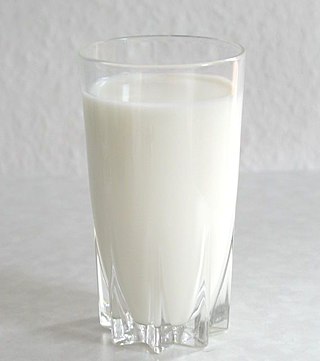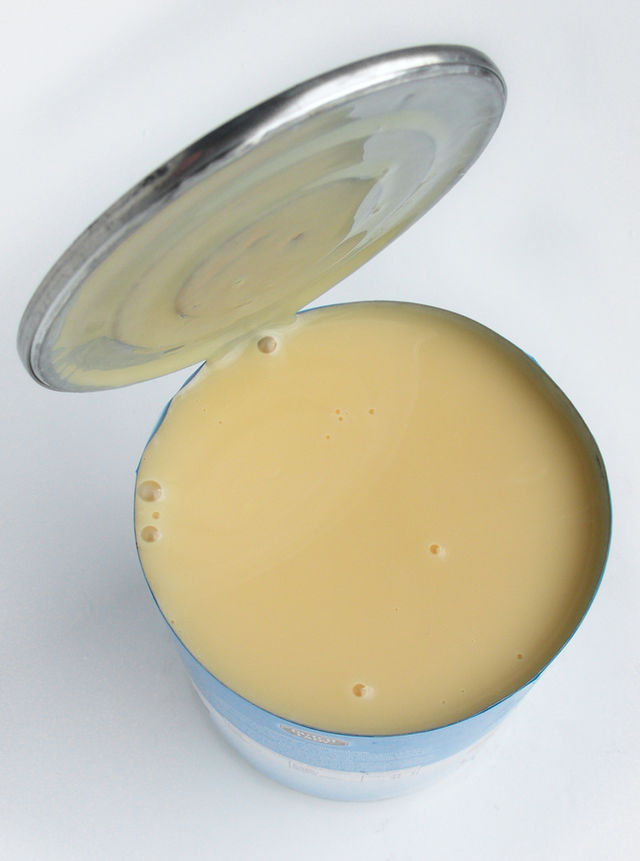Dairy product
Food product made from milk From Wikipedia, the free encyclopedia
Dairy products or milk products, also known as lacticinia or white meats, are food products made from (or containing) milk.[1] The most common dairy animals are cow, water buffalo, nanny goat, and ewe. Dairy products include common grocery store food around the world such as yogurt, cheese, milk and butter.[2][3] A facility that produces dairy products is a dairy.[a][4] Dairy products are consumed worldwide to varying degrees.[5] Some people avoid some or all dairy products because of lactose intolerance, veganism, environmental concerns, other health reasons or beliefs.

Types of dairy product
Summarize
Perspective
Milk


Milk is produced after optional homogenization or pasteurization, in several grades after standardization of the fat level, and possible addition of the bacteria Streptococcus lactis and Leuconostoc citrovorum. Milk can be broken down into several different categories based on type of product produced, including cream, butter, cheese, infant formula, and yogurt.
Milk varies in fat content. Skim milk is milk with zero fat, while whole milk products contain fat.
Milk is an ingredient in many confectioneries. Milk can be added to chocolate to produce milk chocolate.
- Scalded milk
- Condensed milk, milk which has been concentrated by evaporation, with sugar added for reduced process time and longer life in an opened can
- Evaporated milk, (less concentrated than condensed) milk without added sugar
- Baked milk is milk simmered on low heat for long time which results in mild caramelization. Particularly popular in Eastern Europe.
- Dulce de leche
- Malai
- Powdered milk (or milk powder), produced by removing the water from (usually skim) milk
- Khoa, milk which has been completely concentrated by evaporation, used in Indian cuisine
- Infant formula, dried milk powder with specific additives for feeding human infants
- High milk-fat and nutritional products (for infant formulas)
- Whey, the liquid drained from curds and used for further processing or as a livestock feed
- Buttermilk, the liquid left over after producing butter from cream, often dried as livestock feed
- Milk skin
Cream

Cream and fermented cream
- Single cream, double cream and whipped cream
- Clotted cream, thick, spoonable cream made by heating milk
- Kaymak
- Sour cream
- Smetana, Central and Eastern European variety of sour cream
- Crème fraîche, slightly fermented cream
Butter
Butter, mostly milk fat, produced by churning cream
- Ghee, also called clarified butter is made by gentle heating of butter and removal of the solid matter
- Smen, a fermented, clarified butter used in Moroccan cooking
- Anhydrous milkfat (clarified butter)
Fermented

Fermented milk products include:
- Soured milk obtained by fermentation with mesophilic bacteria, mainly Lactococcus lactis and other bacterial cultures and yeasts
- Soured cream and crème fraîche
- Cultured buttermilk resembling buttermilk, but uses different yeast and bacterial cultures
- Clabber, milk naturally fermented to a yogurt-like state
- Filmjölk
- Ymer
- Viili
- Kefir, fermented milk drink from the Northern Caucasus
- Kumis, fermented mares' milk popular in Central Asia
- Amasi
- Mursik
- Quark
Yogurt
Yogurt, milk fermented by thermophilic bacteria, mainly Streptococcus salivarius ssp. thermophilus and Lactobacillus delbrueckii ssp. bulgaricus sometimes with additional bacteria, such as Lactobacillus acidophilus
Cheese
Cheese, produced by coagulating milk, separating curds from whey, and letting it ripen, generally with bacteria, and sometimes also with certain molds.
- Rennet-coagulated cheeses
- Acid-set or sour milk cheeses
- Fresh cheeses and curds, the soft, curdled part of milk (or skim milk) used to make cheese
- Chhena and paneer
- Cream cheese, produced by the addition of cream to milk and then curdled to form a rich curd or cheese
- Whey cheese is a dairy product made from whey and thus technically not cheese.
- Heat and acid coagulation
- Ricotta, acidified whey cheese
- Manouri, anthotyros, mizithra from Greece.
- Brown cheese made of boiled-down whey
- Heat and acid coagulation
Custard
- Custard, thickened with eggs
- Imitation custard, thickened with starch
Frozen

- Ice cream, slowly frozen cream, milk, flavors and emulsifying additives (dairy ice cream)
- Gelato, slowly frozen milk and water, lesser fat than ice cream
- Ice milk, low-fat version of ice cream
- Frozen custard
- Frozen yogurt, yogurt with emulsifiers
Casein
Consumption patterns worldwide
Rates of dairy consumption vary widely worldwide. High-consumption countries consume more than 150 kilograms (330 lb) per capita per year. These countries are: Argentina, Armenia, Australia, Costa Rica, most European countries, Israel, Kyrgyzstan, Canada, the United States and Pakistan. Medium-consumption countries consume 30 kilograms (66 lb) to 150 kg per capita per year. These countries are: India, Iran, Japan, Kenya, Mexico, Mongolia, New Zealand, North and Southern Africa, most of the Middle East, and most of Latin America and the Caribbean. Low-consumption countries consume under 30 kg per capita per year. These countries are: Senegal, most of Central Africa, and most of East and Southeast Asia.[5][6]
Lactose levels
For those with some degree of lactose intolerance, considering the amount of lactose in dairy products can be important to health.
Intolerance and health research
Summarize
Perspective
Dairy products may upset the digestive system in individuals with lactose intolerance or a milk allergy.[7][8][9] People who experience lactose intolerance usually avoid milk and other lactose-containing dairy products, which may cause mild side effects, such as abdominal pain, bloating, diarrhea, gas, and nausea.[7][8] Such individuals may use non-dairy milk substitutes.
Cancer
The American Institute for Cancer Research (AICR), World Cancer Research Fund International (WCRF), Cancer Council Australia (CCA) and Cancer Research UK have stated that there is strong evidence that consumption of dairy products decreases risk of colorectal cancer.[10][11][12][13] The AICR, WCRF, CCA and Prostate Cancer UK have stated that there is limited but suggestive evidence that dairy products increase risk of prostate cancer.[10][11][12][14][15] The American Cancer Society (ACS) have stated that because dairy products "may lower the risk of some cancers and possibly increase the risk of others, the ACS does not make specific recommendations on dairy food consumption for cancer prevention."[16]
It has been suggested that consumption of insulin-like growth factor 1 (IGF-1) in dairy products could increase cancer risk, particularly prostate cancer.[17][18] However, a 2018 review by the Committee on Carcinogenicity of Chemicals in Food, Consumer Products and the Environment (COC) concluded that there is "insufficient evidence to draw any firm conclusions as to whether exposure to dietary IGF-1 is associated with an increased incidence of cancer in consumers".[18] The COC also stated it is unlikely that there would be absorption of intact IGF-1 from food by most consumers.[19]
A 2019 review concluded that higher-quality research was needed to characterise valid associations between dairy consumption and risk of and/or cancer-related mortality.[20] A 2021 umbrella review found strong evidence that consumption of dairy products decreases risk of colorectal cancer.[21] Fermented dairy is associated with significantly decreased bladder cancer and colorectal cancer risk.[22] A 2023 review found no association between consumption of dairy products and breast cancer.[23]
The British Dietetic Association have described the idea that milk promotes hormone related cancerous tumour growth as a myth, stating "no link between dairy containing diets and risk of cancer or promoting cancer growth as a result of hormones".[24] In 2024, Cancer Research UK stated "there is no reliable evidence that casein or hormones in dairy causes cancer in people".[25]
Cardiovascular disease
The American Medical Association (AMA) recommends that people replace full-fat dairy products with nonfat and low-fat dairy products.[26] In 2017, the AMA stated that there is no high-quality clinical evidence that cheese consumption lowers the risk of cardiovascular disease.[27] In 2021, they stated that "taken together, replacing full-fat dairy products with nonfat and low-fat dairy products and other sources of unsaturated fat shifts the composition of dietary patterns toward higher unsaturated to saturated fat ratios that are associated with better cardiovascular health".[26]
In 2017, the National Heart Foundation of New Zealand published an umbrella review which found an "overall neutral effect of dairy on cardiovascular risk for the general population".[28] Their position paper stated that "the evidence overall suggests dairy products can be included in a heart-healthy eating pattern and choosing reduced-fat dairy over full-fat dairy reduces risk for some, but not all, cardiovascular risk factors".[29]
In 2019 the National Heart Foundation of Australia published a position statement on full fat dairy products, "Based on current evidence, there is not enough evidence to recommend full fat over reduced fat products or reduced fat over full fat products for the general population. For people with elevated cholesterol and those with existing coronary heart disease, reduced fat products are recommended."[30] The position statement also noted that the "evidence for milk, yoghurt and cheese does not extend to butter, cream, ice-cream and dairy-based desserts; these products should be avoided in a heart healthy eating pattern".[30]
Recent reviews of randomized controlled trials have found that dairy intake from cheese, milk and yogurt does not have detrimental effects on markers of cardiometabolic health.[31][32]
Other
Consumption of dairy products such as low-fat and whole milk have been associated with an increased acne risk, however, as of 2022[update] there is no conclusive evidence.[33][34][35] Fermented and low-fat dairy products are associated with a decreased risk of diabetes.[36][37] Consumption of dairy products are also associated with a decreased risk of gout.[38]
A 2023 review found that higher intake of dairy products is significantly associated with a lower risk of inflammatory bowel disease.[39]
Avoidance on principle
Summarize
Perspective
Some groups avoid dairy products for non-health-related reasons. Some religions restrict or do not allow the consumption of dairy products. For example, some scholars of Jainism advocate not consuming any dairy products because dairy is perceived to involve violence against cows.[40] Orthodox Judaism requires that meat and dairy products not be served at the same meal, served or cooked in the same utensils, or stored together, as prescribed in Deuteronomy 14:21.[41]
Veganism is the avoidance of all animal products, including dairy products, most often due to the ethics regarding how dairy products are produced. The ethical reasons for avoiding meat and dairy products include how dairy is produced, how the animals are handled, and the environmental effect of dairy production.[42][43] According to a report of the United Nations' Food and Agriculture Organization in 2010 the dairy sector accounted for 4 percent of global human-made greenhouse gas emissions.[44][45]
Growing awareness of dairy products' environmental impact, specifically greenhouse gas emissions, has led to many people reducing or avoiding dairy. In the EU, dairy is responsible for 27% of all diet related emissions, on average, while plant-based milks cause 2.5–4.5 times fewer emissions.[46][47]
See also
References and notes
Further reading
Wikiwand - on
Seamless Wikipedia browsing. On steroids.

